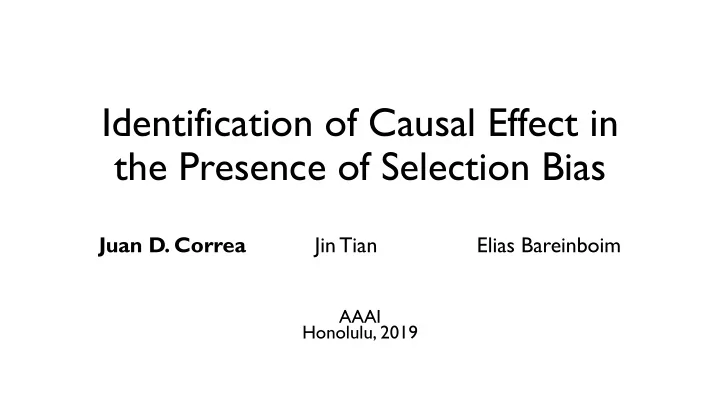

Identification of Causal Effect in the Presence of Selection Bias Juan D. Correa Jin Tian Elias Bareinboim AAAI Honolulu, 2019
Challenge 1: Confounding Bias Age What’s the causal effect of Exercise on Cholesterol ? What about 𝑄 𝑑ℎ𝑝𝑚𝑓𝑡𝑢𝑓𝑠𝑝𝑚 𝑓𝑦𝑓𝑠𝑑𝑗𝑡𝑓) ? Exercise Cholesterol Cholesterol Exercise (Hours) 2
Challenge 1: Confounding Bias Age Age 10 Age 30 Age 50 Age 20 Age 40 Exercise Cholesterol Cholesterol Exercise (Hours) 3
Challenge 1: Confounding Bias Age Age 10 Age 30 Age 50 Age 20 Age 40 Exercise Cholesterol 𝑄 𝑑ℎ𝑝𝑚𝑓𝑡𝑢𝑓𝑠𝑝𝑚 𝑒𝑝(𝑓𝑦𝑓𝑠𝑑𝑗𝑡𝑓)) Cholesterol ≠ 𝑄(𝑑ℎ𝑝𝑚𝑓𝑡𝑢𝑓𝑠𝑝𝑚 | 𝑓𝑦𝑓𝑠𝑑𝑗𝑡𝑓) This difference is called Confounding Bias Exercise (Hours) 4
Age Challenge 2: Selection Bias Exercise Cholesterol Variables in the system affect the inclusion of units in the sample S Fitness S=0 Cholesterol S=1 Exercise (Hours) 5
Age Challenge 2: Selection Bias Exercise Cholesterol Variables in the system affect the inclusion of units in the sample S Fitness S=0 𝑄(𝑏𝑓, 𝑓𝑦, 𝑑ℎ, 𝑔𝑗𝑢) Cholesterol ≠ 𝑄 𝑏𝑓, 𝑓𝑦, 𝑑ℎ, 𝑔𝑗𝑢 𝑇 = 1) S=1 This difference is due to Selection Bias Exercise (Hours) 6
Current literature No Confounding Confounding No Selection Complete Algorithms Association = Causation [Tian and Pearl ’02; Huang and No control Valtorta ’06; Shpitser and Pearl ’06; Bareinboim and Pearl ’12] RCE Controlling Selection Bias [ Bareinboim, Tian, Pearl ’15 ] Selection [Bareinboim and Pearl ’12] Generalized Adjustment Recovering from Selection Bias in [Correa, Tian, Bareinboim ’18] Causal and Statistical Inference IDSB [Bareinboim, Tian, Pearl ’14] [Correa, Tian, Bareinboim ’19] 7
Problem I Is there a function 𝑔 such that Given: Variables 𝒀, 𝒁 𝑄 𝒛 𝑒𝑝 𝒚 = 𝑔(𝑄 ; ) 𝑇 𝑄(𝒘|𝑇 = 1) ? 1 … 1 … 1 … 𝑄 8
Result 1 Theorem 1: Let 𝒀, 𝒁 ⊂ 𝑾 be two disjoint sets of variables and a causal diagram over 𝑾 and 𝑇 . If 𝒁 ⊥ 𝑇 𝒀𝒁 CDE , then 𝑄 𝒚 (𝒛) is not recoverable from 𝑄(𝒘 | 𝑇 = 1) in . 9
Problem II Is there a function 𝑔 such that Given: Variables 𝒀, 𝒁 𝑄 𝒛 𝑒𝑝 𝒚 = 𝑔(𝑄 ; , 𝑄 F ) 𝑇 𝑄(𝒘|𝑇 = 1) 𝑄(𝒖) ? 1 … … 1 … … 1 … … 𝑄 𝑄 F ; 10
Result II Algorithm IDSB Given a causal diagram, a selection-biased distribution and external data over a subset of the variables and the variables of interest ( 𝒀, 𝒁 ); returns an expression for 𝑄 𝒚 (𝒛) in terms of the input or failure . Strictly more powerful than the best known algorithm that accepts both biased and unbiased data. 11
� Decomposing the Problem Intervention X W 1 W 2 W 3 Y X W 1 W 2 W 3 Y S S 𝑄 H 𝑧 = J 𝑄 H (𝑧, 𝑥 L , 𝑥 F , 𝑥 ; ) N O ,N P ,N Q 12
� � Decomposing the Problem C-Components W 2 Y 𝑄 H,N O ,N Q 𝑧, 𝑥 F 𝑄 N P ,R 𝑥 L , 𝑥 ; W 1 W 3 X W 1 W 2 W 3 Y S S 𝑄 H 𝑧 = J 𝑄 H (𝑧, 𝑥 L , 𝑥 F , 𝑥 ; ) = J 𝑄 H,N O ,N Q 𝑧, 𝑥 F 𝑄 N P ,R 𝑥 L , 𝑥 ; N O ,N P ,N Q N O ,N P ,N Q 13
Summary 1. Complete characterization recoverable causal effects from the causal diagram and a selection-biased probability distribution. 2. Sufficient procedure to recover causal effects from a causal diagram, selection-biased distributions and auxiliary unbiased data which is strictly more powerful than state-of- the-art procedure. Thanks! 14
15
Recommend
More recommend